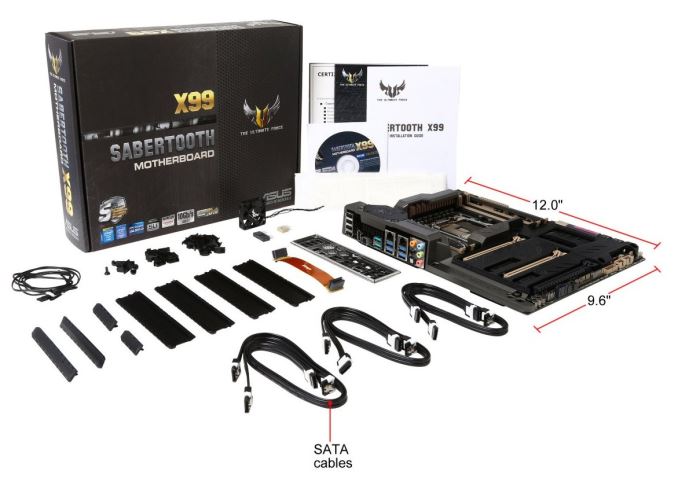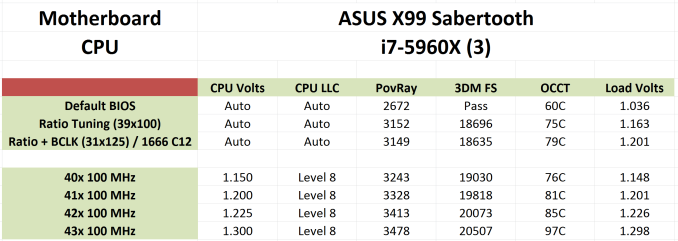The ASUS TUF X99 Sabertooth Review
by Ian Cutress on July 22, 2015 10:00 AM EST- Posted in
- Motherboards
- Asus
- TUF
- X99
ASUS TUF X99 Sabertooth In The Box
From the introduction page we’ve already pointed out that the Sabertooth comes with slot and port guards to protect against dust and sand, but the package also comes with the power delivery fan, three thermistors, six SATA cables, a Q-connector for the front panel header, a single flexi-SLI bridge, the rear IO shield, a driver disk and manuals
There wasn’t much else that ASUS could add to this box that would focus on the market this is intended for.
Many thanks to...
We must thank the following companies for kindly providing hardware for our test bed:
Thank you to AMD for providing us with the R9 290X 4GB GPUs.
Thank you to ASUS for providing us with GTX 980 Strix GPUs and the R7 240 DDR3 GPU.
Thank you to ASRock and ASUS for providing us with some IO testing kit.
Thank you to Cooler Master for providing us with Nepton 140XL CLCs.
Thank you to Corsair for providing us with an AX1200i PSU.
Thank you to Crucial for providing us with MX200 SSDs.
Thank you to G.Skill and Corsair for providing us with memory.
Thank you to MSI for providing us with the GTX 770 Lightning GPUs.
Thank you to OCZ for providing us with PSUs.
Thank you to Rosewill for providing us with PSUs and RK-9100 keyboards.
Test Setup
| Test Setup | |
| Processor | Intel Core i7-5960X ES 8 Cores, 16 Threads, 3.0 GHz (3.5 GHz Turbo) |
| Motherboards | ASUS TUF X99 Sabertooth |
| Cooling | Cooler Master Nepton 140XL |
| Power Supply | OCZ 1250W Gold ZX Series Corsair AX1200i Platinum PSU |
| Memory | Corsair DDR4-2133 C15 2x8 GB 1.2V or G.Skill Ripjaws 4 DDR4-2133 C15 2x8 GB 1.2V |
| Memory Settings | JEDEC @ 2133 |
| Video Cards | ASUS GTX 980 Strix 4GB MSI GTX 770 Lightning 2GB (1150/1202 Boost) ASUS R7 240 2GB |
| Hard Drive | Crucial MX200 1TB |
| Optical Drive | LG GH22NS50 |
| Case | Open Test Bed |
| Operating System | Windows 7 64-bit SP1 |
ASUS TUF X99 Sabertooth Overclocking
Experience with ASUS TUF X99 Sabertooth
The X99 Sabertooth sits between a rock and hard place when it comes to overclocking. X99 is a chipset which enables overclocking, and almost every motherboard for the platform is built to handle it. By virtue of the upgraded components leading to the 5-year warranty on the Sabertooth, one could argue that it already fulfills the requirement for being built towards holding an overclock. Nevertheless, the software does not outwardly promote overclocking, instead focusing on longevity. For a proper overclock, the BIOS has two auto-overclock options (CPU Level Up) or the full range of manual overclock settings.
Methodology
Our standard overclocking methodology is as follows. We select the automatic overclock options and test for stability with PovRay and OCCT to simulate high-end workloads. These stability tests aim to catch any immediate causes for memory or CPU errors.
For manual overclocks, based on the information gathered from previous testing, starts off at a nominal voltage and CPU multiplier, and the multiplier is increased until the stability tests are failed. The CPU voltage is increased gradually until the stability tests are passed, and the process repeated until the motherboard reduces the multiplier automatically (due to safety protocol) or the CPU temperature reaches a stupidly high level (100ºC+). Our test bed is not in a case, which should push overclocks higher with fresher (cooler) air.
Overclock Results
Both of the automatic overclocks did well, scoring under 80C at load although arguably 3.9 GHz isn’t much to shout about. The fact that the second CPU Level Up option put the memory at DDR4-1666 C12 was a little odd as well. For manual overclocks, we were restricted by our bad CPU sample, but 4.3 GHz came easily enough before hitting 100C+ during an AVX load.












57 Comments
View All Comments
Shadowmaster625 - Wednesday, July 22, 2015 - link
lol it even has dust caps for the microphone port.Stuka87 - Wednesday, July 22, 2015 - link
Really a nice looking board. I like the PCI-E covers one slots you may not be using.Out of curiosity, why are you guys still testing with Windows 7 rather than 8.1? Will you guys be moving to Windows 10 soon?
AndrewJacksonZA - Wednesday, July 22, 2015 - link
As soon as it's commercially available and all benchmark software has been tested to make sure that they still work I hope. :-)Souka - Thursday, July 23, 2015 - link
What about Windows 8.1?abrowne1993 - Wednesday, July 22, 2015 - link
"It didn’t detect the DDR3 on the graphics card correctly though!"GDDR5?
Ryan Smith - Wednesday, July 22, 2015 - link
The R7 240 is a DDR3 card.Achaios - Wednesday, July 22, 2015 - link
@Staff: There is a rather huge issue with ASUS X99 motherboards destroying CPU's (5960X's, 5820k's, etc). Google "5960X Dead overclock.net".To my understanding, there is a chance that the ASUS X99 motherboard will raise on its own the CPU Vcore of the CPU to around 1.85V which, as we have learned, kills CPUs in a matter of seconds.
The latest incident reported was 4.5 hours ago. ASUS has refused to comment or acknowledge the issue. So, in view of the above, I would not buy an ASUS X99.
Achaios - Wednesday, July 22, 2015 - link
Correction: Latest incident reported 2 days and 8 hours ago on a "RVE", i.e. Rampage V Extreme X99. According to the person writing the report, he did try to RMA the board butQUOTE "ASUS were just dismissive and very unfriendly and said no".
Treating enthusiasts like dogs really angers me.
Gothmoth - Wednesday, July 22, 2015 - link
lol.... "enthusiast" who probably killed their system because they have no clue how to overclock.now they claim it´s a board problem. of course all x99 asus boards are affected.
i have SIX asus X99 boards and they run flawless for years.
an where is the source for the "incident" you reported?
without giving a source this is even more likr UFO sightings.....
Achaios - Wednesday, July 22, 2015 - link
http://www.overclock.net/t/1561131/5960x-dead